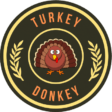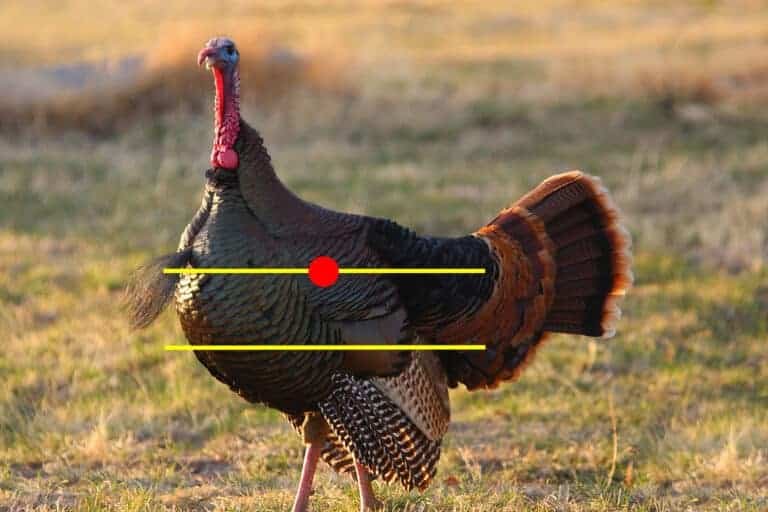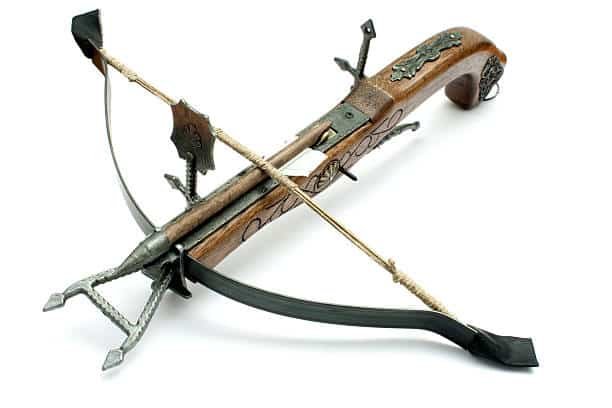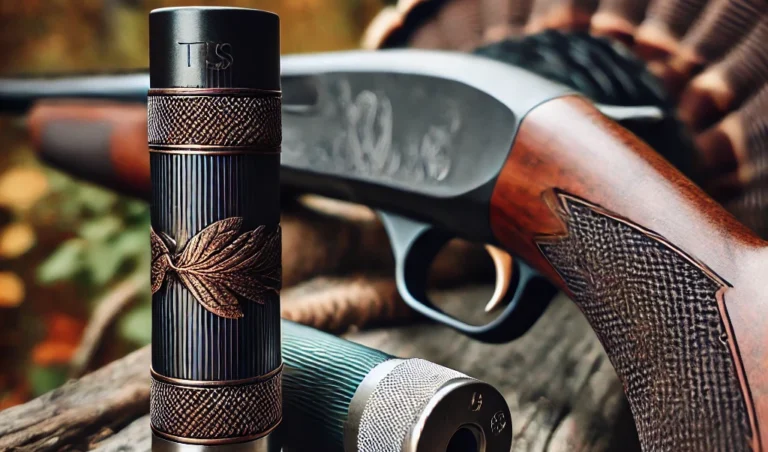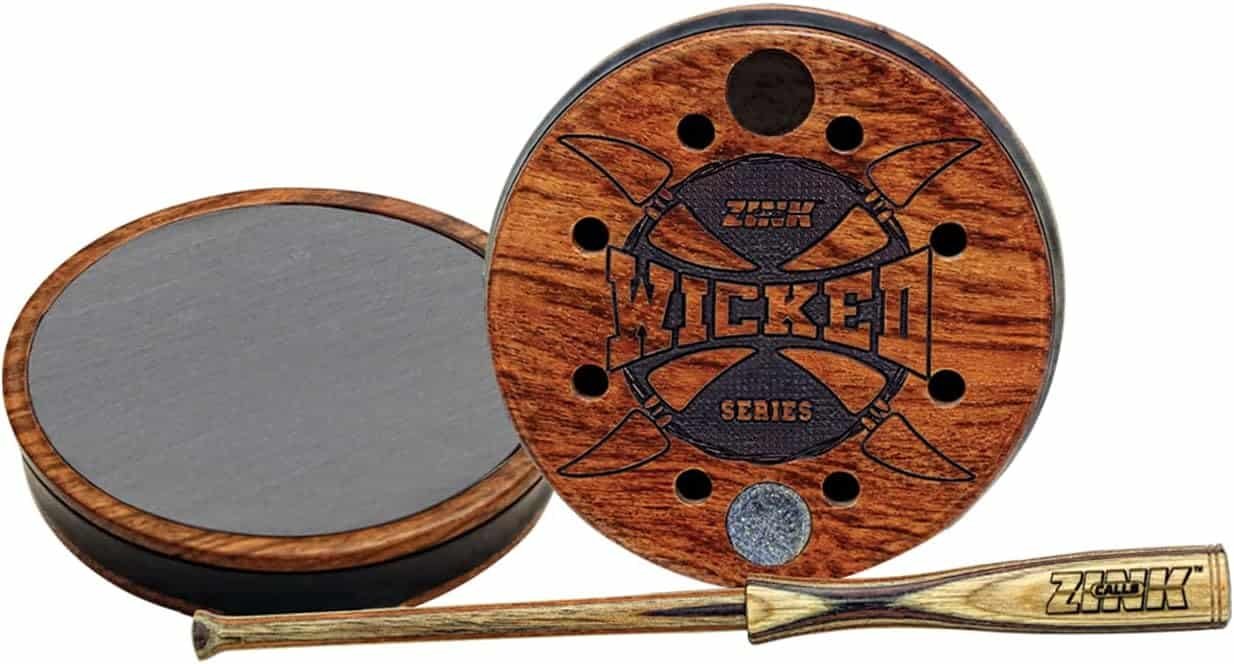Best Turkey Hunting Camo for Ultimate Concealment in 2024
Hey there, fellow turkey chasers! If you’ve ever had a keen-eyed gobbler bust you from 100 yards out, you know just how important camo is. Today, we’re diving deep into the world of turkey hunting camo. Trust me, after 20 years of chasing these birds, I’ve learned a thing or two about staying hidden.
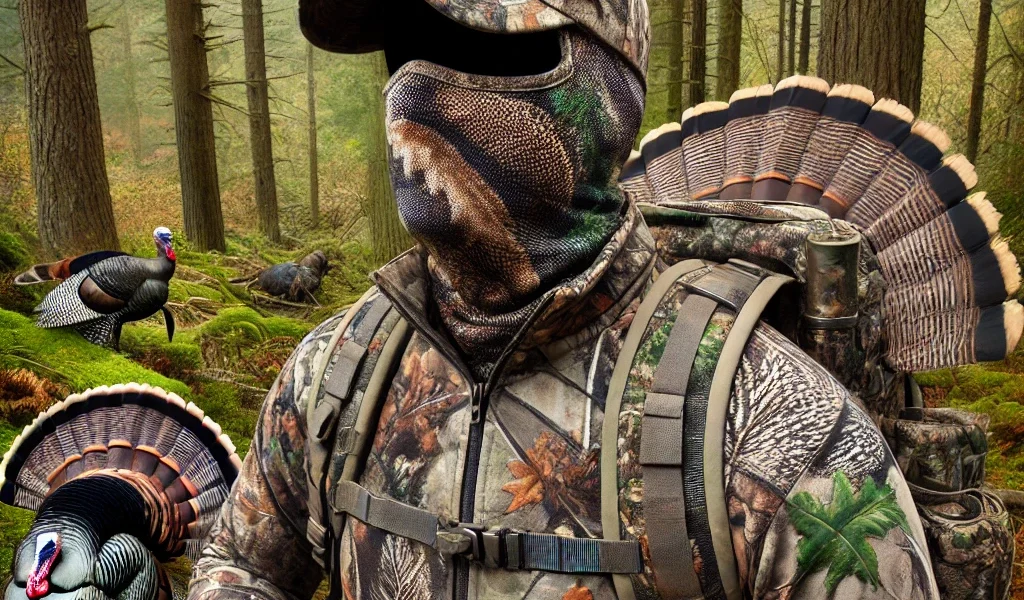
When venturing into the exciting world of turkey hunting, one must not overlook the significance of proper camouflage. Turkey hunting camo is designed to help hunters blend seamlessly with their surroundings, reducing their visibility and increasing their chances of success.
Whether you’re a seasoned hunter or a novice pursuing these elusive birds, understanding the ins and outs of turkey hunting camo is essential for a fruitful and fulfilling experience.
Understanding Turkey Vision
First things first—let’s talk turkey eyesight. Believe me, these aren’t your average barnyard birds. Turkeys have some of the sharpest eyes in the woods, and understanding how they see the world is key to staying hidden.
Wild turkeys have incredible color vision thanks to their tetrachromatic eyes, which means they can see a broader spectrum of colors than humans. They’re especially good at picking up blues and reds, so you’ll rarely see these colors in hunting camo.
But it’s not just about color. Turkeys have excellent visual acuity, meaning they can detect even the slightest movement from far away. Their eyes are positioned on the sides of their head, giving them a wide field of view. This adaptation allows them to spot predators (or hunters) approaching from almost any direction.
Something that might surprise you is that turkeys can also see in UV light. This means they might perceive certain “camo” patterns differently than we do. Some detergents and brighteners used in washing clothes can make them appear to glow in UV light, making you stand out like a sore thumb in the woods.
Remember, we’re not just hiding from their eyes but from their survival instincts honed over millions of years. These birds have evolved to detect and avoid predators; in their eyes, that’s exactly what we are.
So, what does all this mean for us hunters? It means our camo game needs to be on point. We need to think beyond just matching the colors of our surroundings. We must break up our outline, eliminate shine, and stay dead still. It’s a challenge, but that’s what makes turkey hunting so exciting!
Choosing the Right Camo Pattern
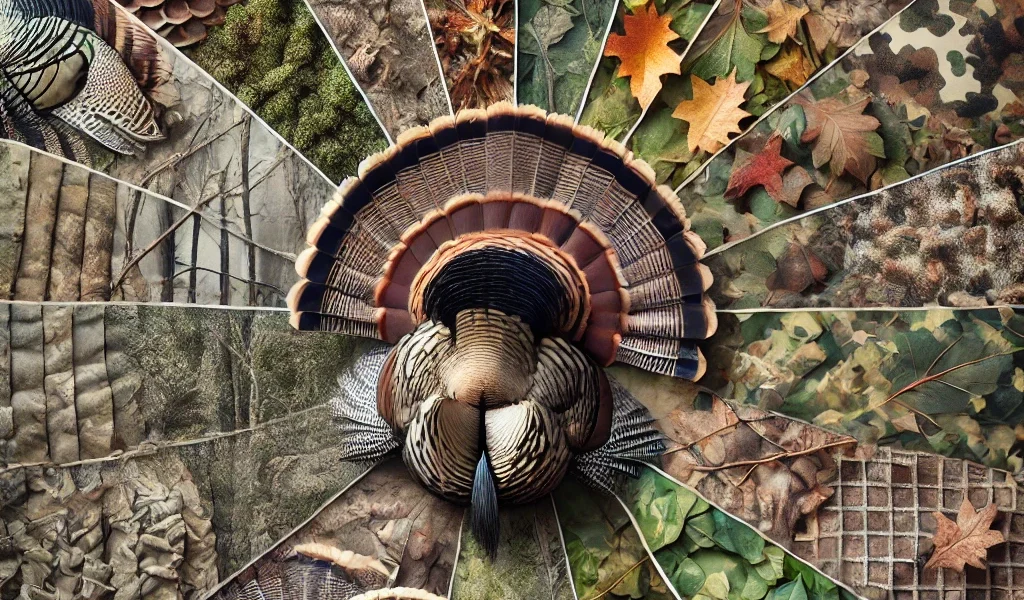
Now that we understand how turkeys see, let’s discuss picking the perfect camo pattern to fool those sharp eyes. Not all camo is created equal in turkey hunting, and choosing the right pattern can make or break your hunt.
The key to effective turkey hunting camo is breaking up your outline and blending with your surroundings. You want a pattern that creates a 3D effect, mimicking the depth and shadows of natural foliage. This is why simple, solid colors or old-school military patterns won’t cut it.
Here are some top choices that have served me well over the years:
Mossy Oak Obsession: This pattern is designed specifically for turkey hunting. It features a mix of tree bark, leaves, and branches that perfectly mimic the spring woods. The subtle green tones blend well with early spring foliage.
Realtree Edge: Another excellent choice, Edge combines pine, oak, and maple elements with open areas that create a shadowy 3D effect. It’s versatile enough to work in a variety of habitats.
KUIU Verde 2.0: This pattern is hard to beat if you’re hunting in areas with a lot of green undergrowth. Its micro and macro patterns create depth, helping you disappear into leafy backgrounds.
Natural Gear: This pattern uses a neutral blend of twigs, leaves, and bark. It’s particularly effective in more open, dried-out areas.
But here’s the thing – the “best” pattern can vary depending on where and when you’re hunting. This is where scouting your hunting area becomes crucial. Take note of the dominant colors and textures in your hunting spot. Is it mostly brown and gray? Lots of green undergrowth? Open fields or dense forest?
Pro tip: Match your camo to your hunting area and the season. Early spring might need more browns and grays to match bare trees and last year’s leaves. As the season progresses, you might need to switch to patterns with more green to blend with new foliage.
Don’t forget about the specific part of the woods you’ll be in. If you’re setting up near a cluster of pine trees, a pattern heavy on pine needles and bark might be best. Are you hunting near oaks? Look for a pattern that incorporates oak leaves and bark.
Another factor to consider is the distance you expect to encounter turkeys. Patterns with larger elements work well at longer distances, while finer, more detailed patterns are better for close encounters.
Remember, no single pattern is perfect for all situations. Many serious turkey hunters have multiple camo sets for different conditions. It might seem overkill, but when that big tom hangs up just out of range, you’ll be glad you put in the extra effort to match your surroundings perfectly.
Head-to-Toe Turkey Hunting Clothes
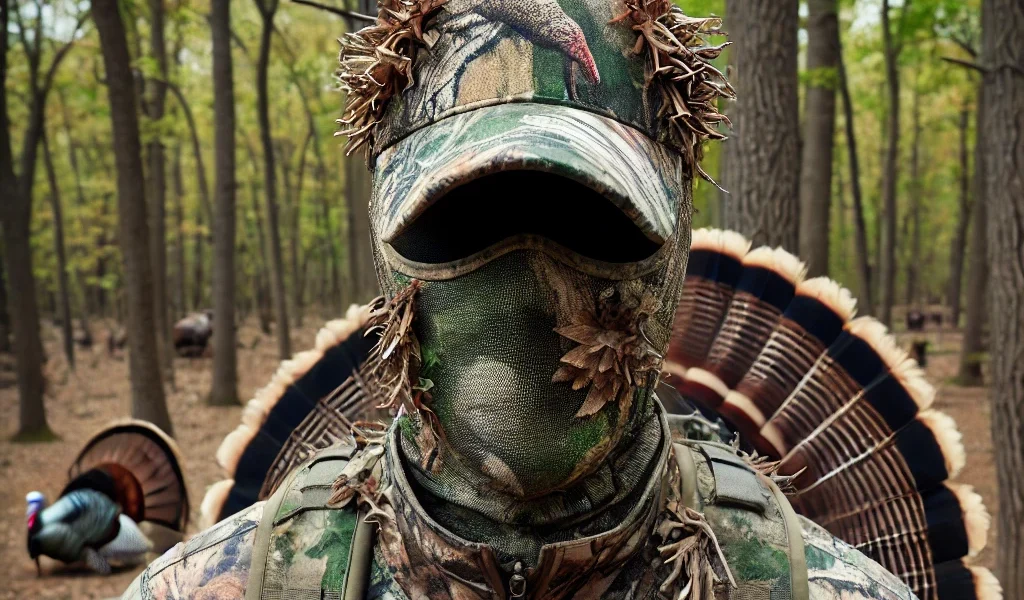
Alright, folks, this is where the rubber meets the road. When I say head-to-toe, I mean it! Turkeys don’t miss a trick; one uncovered skin patch can blow your setup. Let’s break it down from top to bottom:
Head
Start with a good camo hat or head net. A wide-brimmed boonie hat can help shade your face and break up your silhouette. If you’re using a head net, make sure it’s not too tight – you want some shadows and depth to break up the roundness of your head.
Face
This is crucial. A human face is a dead giveaway to turkeys. You’ve got two main options here:
Face paint: This allows for more flexibility and comfort in warm weather. Use a combination of dark and light colors to break up your features. Don’t forget your ears and under your chin!
Face mask: A mesh face mask can be more convenient and less messy than paint. Look for one that matches your main camo pattern.
Pro Tip: If you wear glasses, consider a camo headset with a mesh face panel that covers your entire head and neck. This helps hide the shine from your lenses.
Upper Body
A good camo jacket or long-sleeved shirt is essential. Look for one with a breakup pattern that matches your surroundings. Some hunters prefer layering with a camo undershirt for those unpredictable spring temperatures.
Hands
Remember your hands—camo gloves are a must. Choose thin gloves that allow good dexterity when calling or handling your weapon. Fingerless gloves can be a good compromise in warmer weather.
Turkey Hunting Pants
And please, leave those blue jeans at home. I’ve seen too many hunts ruined by a flash of denim. Invest in good turkey hunting pants that match your jacket. Some hunters prefer bib overalls for extra coverage and comfort when sitting for long periods.
Feet
While turkeys might not often see your feet, don’t neglect them. Camo boots or boot covers can help, especially if you’re hunting from a ground blind where your feet might be visible.
Extra Coverage
Consider a 3D leafy suit or a ghillie suit for those tough birds. These add an extra layer of texture that can be incredibly effective at breaking up your outline. Just be careful not to get too bulky – you still need to be able to move and shoot!
Remember, every bit of you should blend in. Even small things like a watch with a shiny face or a bright wedding ring can catch the sun and alert a turkey to your presence.
One last thing – don’t forget about scent control. While turkeys don’t have a great sense of smell, other animals in the woods do. Use scent-free detergent on your camo and store it in a sealed container with pine needles or leaves from your hunting area. This extra step can prevent other wildlife from alerting turkeys to your presence.
The Best Turkey Hunting Gear
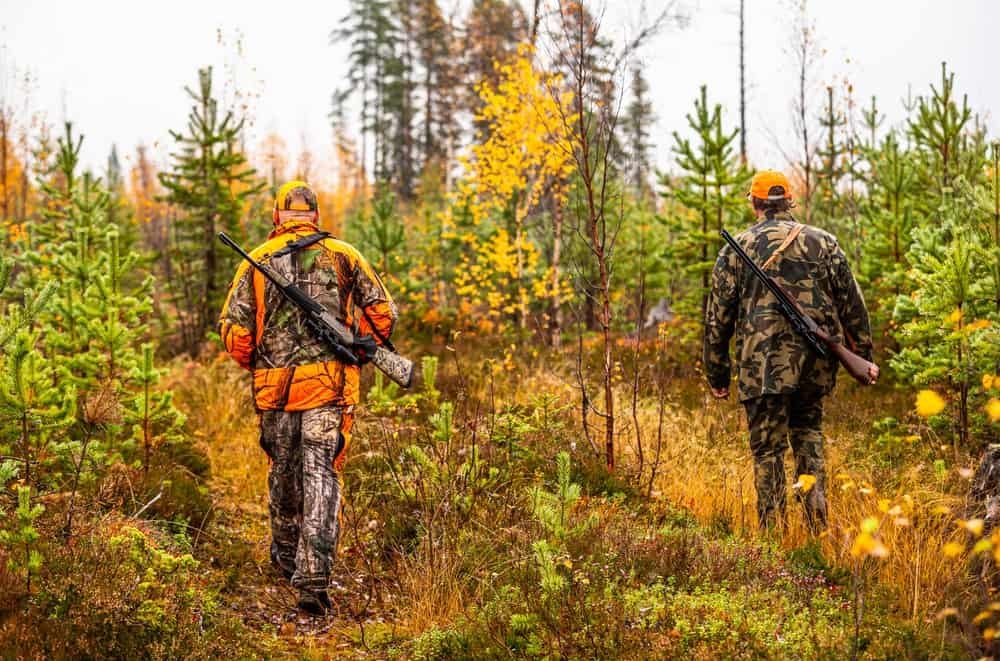
Now that we’ve covered you in camo from head to toe, let’s talk about shape. Turkeys are experts at spotting human shapes, even when covered in the best camo pattern money can buy. That’s where breaking up your outline comes into play.
The Human Shape Problem
Even in full camo, a person sitting against a tree is still a person-shaped blob. Turkeys have evolved to be wary of predators, and anything that looks vaguely human-shaped sets off alarm bells in their bird brains. So, how do we solve this? Let’s break it down:
3D Camo
This is where 3D camo shines. Leafy suits or ghillie suits can be game-changers when it comes to breaking up your outline. These suits add a layer of texture and depth that helps you blend into the surrounding foliage.
Leafy Suits: These are lightweight and easy to wear over regular camo. The loose, leaf-like pieces move with the breeze, mimicking natural vegetation. They’re particularly effective in areas with lots of underbrush.
Ghillie Suits: Originally developed for military snipers, ghillie suits are the ultimate concealment. They’re bulkier than leafy suits but can be incredibly effective, especially in more open terrain.
Pro Tip: If using a 3D suit, practice moving and shooting in it before your hunt. They can take some getting used to!
Natural Vegetation
Sometimes, nature provides the best camouflage. When setting up your hunting spot, use nearby branches, leaves, or grass to break up your outline. Tuck some leafy branches around you, or use tall grass to your advantage.
Caution: Be mindful of movement. While natural vegetation can be great for concealment, it can draw attention to you if it moves unnaturally when you shift position.
Positioning
How you position yourself can make a big difference in breaking up your outline:
- Use Trees Wisely: Sit with your back against a tree wider than your shoulders. This immediately breaks up your silhouette.
- Shadows Are Your Friend: Set up in shadowy areas. The dappled light will naturally break up your outline.
- Blend with Bigger Shapes: Position yourself near larger elements in the landscape – bushes, fallen logs, or rock formations. Your shape will blend in with these larger, natural forms.
Equipment Considerations
Don’t forget about your gear. A gun or bow can create straight lines that don’t occur in nature:
- Camo Wraps: Use camo tape or fabric wraps on your gun or bow to break up their outlines.
- Natural Covers: In a pinch, you can use natural materials like leaves or grass to cover your weapon. Just be sure not to interfere with its function!
- Positioning: Hold your weapon in a way that aligns with natural lines in your environment, such as along the line of a fallen log or vertically against a tree trunk.
The Movement Factor
Remember, even the best outline-breaking techniques won’t help if you move around like a jumping jack. Practice sitting still for long periods. Do it slowly and deliberately when you need to move, especially when a turkey is in sight.
Pro Tip: If you cannot sit still, you must hide your body from view, either behind fabric wraps, inside a tent, or in a ground blind. Trust me on this one – you will not see anything if you are moving.
By combining good camo patterns with these outline-breaking techniques, you’ll be well on your way to becoming invisible in the turkey woods. In our next section, we’ll talk about extending this camouflage concept to your gear, because a well-hidden hunter with shiny, obvious equipment is still a busted hunter!
Don’t Forget Your Gear
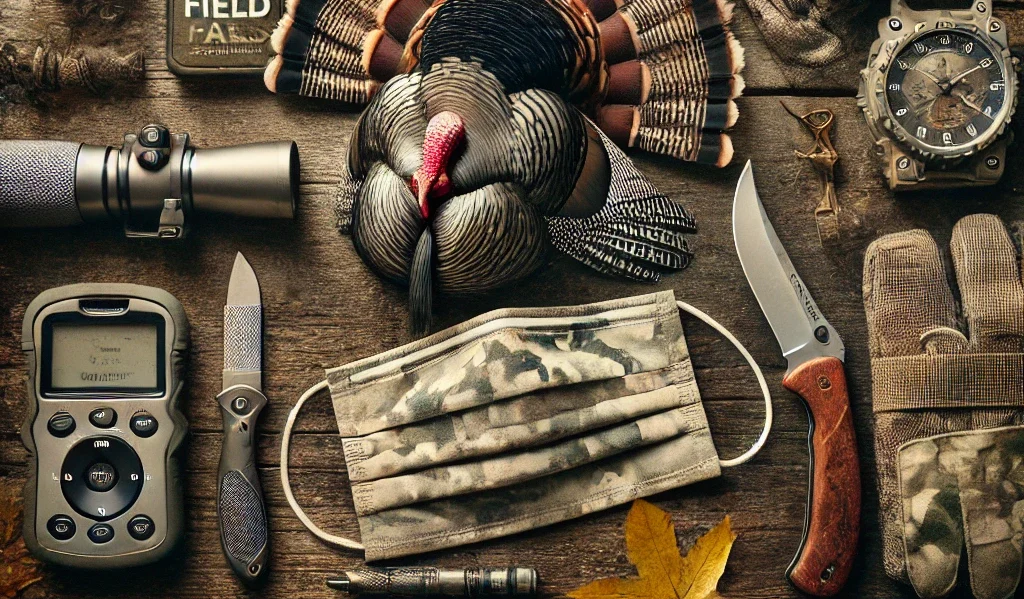
Alright, turkey hunters, you’re looking good in your camo, and you’ve mastered the art of breaking up your outline. But hold up – we’re not done yet! Your gear needs to play hide-and-seek too. A shiny gun barrel or a bright white cooler can undo all your careful camouflaging in a heartbeat. Let’s dive into how to keep your equipment under wraps.
Firearms and Bows
Your weapon is often the biggest challenge when it comes to gear concealment. Those long, straight lines and shiny surfaces are dead giveaways to sharp-eyed gobblers.
- Camo Wraps: Gun and bow wraps are a turkey hunter’s best friend. These fabric or neoprene covers slip over your firearm or bow, hiding shiny surfaces and breaking up the straight lines. Choose a wrap that matches your main camo pattern.
- Camo Tape: For a more customizable option, use camo tape or specialized gun tape. This allows you to cover specific parts of your weapon and create your pattern.
- Paint: Some hardcore hunters opt to paint their guns or bows. If you go this route, use a matte finish to avoid shine, and consider getting it done professionally to avoid damaging your weapon.
Pro Tip: Remember your scope! A scope cover in a matching camo pattern can prevent sun glare from giving away your position.
Calls and Other Small Gear
Those shiny slate calls and metal strikers can catch the sun like a mirror. Here’s how to handle them:
- Camo Pouches: Keep calls in a camo pouch attached to your vest. Only take them out when you’re ready to use them.
- DIY Camo: You can apply camo tape or paint directly to wooden or plastic calls. For metal parts, consider using matte spray paint designed for metal surfaces.
- Natural Materials: Some traditionalists prefer to use natural materials like river cane for strikers, which are already camo-colored.
Blinds and Seats
If you’re using a ground blind or a seat, these need camouflaging, too:
- Brush In Your Blind: Never set up a ground blind without brushing it in. Use natural vegetation from the immediate area to break up the blind’s outline and help it blend in.
- Camo Netting: For run-and-gun style hunting, a simple camo netting can quickly conceal your seat and create a makeshift blind.
- Seat Camo: Choose a seat or cushion in a camo pattern that matches your clothing. Avoid bright colors, even on the underside.
Accessories
Don’t overlook the small stuff:
- Water Bottles: Use camo koozies or wrap to cover shiny or brightly colored water bottles.
- Backpacks: If you carry a pack, ensure it matches the camo pattern.
- Watch: If you wear a watch, consider one with a camo strap or one that covers the face when not used.
- Decoys: While not the gear you wear, make sure your decoys are realistically painted and not too shiny. Some hunters even dust their decoys with dirt to reduce shine and add realism.
Electronics
In this age of smartphone hunting apps and video cameras, electronics pose a new challenge:
- Phone Cases: Use a camo phone case, and always set your screen brightness to the lowest setting.
- Camera Gear: Cover your camera and tripod with camo tape or covers if you’re filming your hunt.
Remember, camouflaging your gear isn’t just about looks. Eliminating shine and reducing noise (like the crinkling of a plastic water bottle) are equally important. Every piece of gear should be evaluated for its function and how well it can be concealed.
Movement is the Enemy

Alright, turkey hunters, we’ve covered you in camo from head to toe and hidden your gear. But here’s the cold, hard truth: even the best camouflage in the world can’t hide movement. Movement is the number one way hunters get busted by keen-eyed gobblers. Let’s dive into how to stay still and move only when necessary.
The Turkey’s Motion Detector
First, let’s understand why movement is so deadly. Like many prey animals, turkeys have eyes that are incredibly sensitive to motion. It’s a survival adaptation – in the wild, movement often means predator, and predator means danger.
A turkey can detect the slightest twitch from hundreds of yards away. So, how do we overcome this?
The Art of Sitting Still
Patience isn’t just a virtue in turkey hunting – it’s a necessity. Here’s how to master the art of sitting still:
- Choose Your Setup Wisely: Pick a spot where you can sit comfortably for long periods. A tree wide enough to support your back is ideal.
- Get Comfortable: Use a good cushion or seat. Being uncomfortable leads to fidgeting, which leads to getting busted.
- Position Your Gear: Have everything you need within easy reach. Fumbling for calls or shells means unnecessary movement.
- Practice at Home: Seriously, practice sitting still for long periods. It’s harder than you think!
- Breath Control: Learn to breathe slowly and steadily. Rapid breathing can cause noticeable movement.
Pro Tip: If you must scratch an itch or swat a bug, do it when the turkey is behind a tree or looking away.
When You Must Move
Sometimes, movement is unavoidable. Here’s how to do it right:
- Move Like Molasses: When you need to shift position or raise your gun, do it incredibly slowly. I’m talking glacier-pace here.
- Use Natural Movements: Try to mimic the movement of shadows or vegetation in the breeze. Erratic, jerky movements are a dead giveaway.
- Wait for Cover: If possible, wait to move until the turkey is behind vegetation or looking away.
- The Turkey Shuffle: Some hunters use a slow, shuffling walk that mimics a turkey’s movement when walking in the open. It looks silly, but it can be effective!
Calling and Movement
Calling presents a unique challenge because it often requires hand movement. Here’s how to handle it:
- Use Hands-Free Calls: Mouth calls allow you to call without moving your hands.
- Conceal Your Calling Hand: If using a friction call, keep your calling hand close to your body and shielded from the turkey’s view.
- Call Less: Often, less is more when turkeys call. Every time you call, you risk movement that could give you away.
Dealing with Long Waits
Staying still for hours can be mentally and physically challenging. Here are some tips:
- Mental Games: Play mental games or practice meditation to keep your mind occupied without moving.
- Micro-Movements: If you must move, make tiny, incremental movements over a long period.
- Stay Alert: Use your ears more than your eyes. Turkeys are noisy birds, and often, you’ll hear them before you see them.
The Wind Factor
Wind can be both friend and foe when it comes to movement:
- Use the Wind: Some movement is more forgivable on windy days when everything moves.
- Beware of Calm: On still days, even the slightest movement stands out.
Remember, turkeys aren’t looking for perfection—they’re looking for anything that doesn’t belong. Minimizing your movement eliminates one of the biggest red flags that alert turkeys to a predator’s presence.
Scent Control Matters
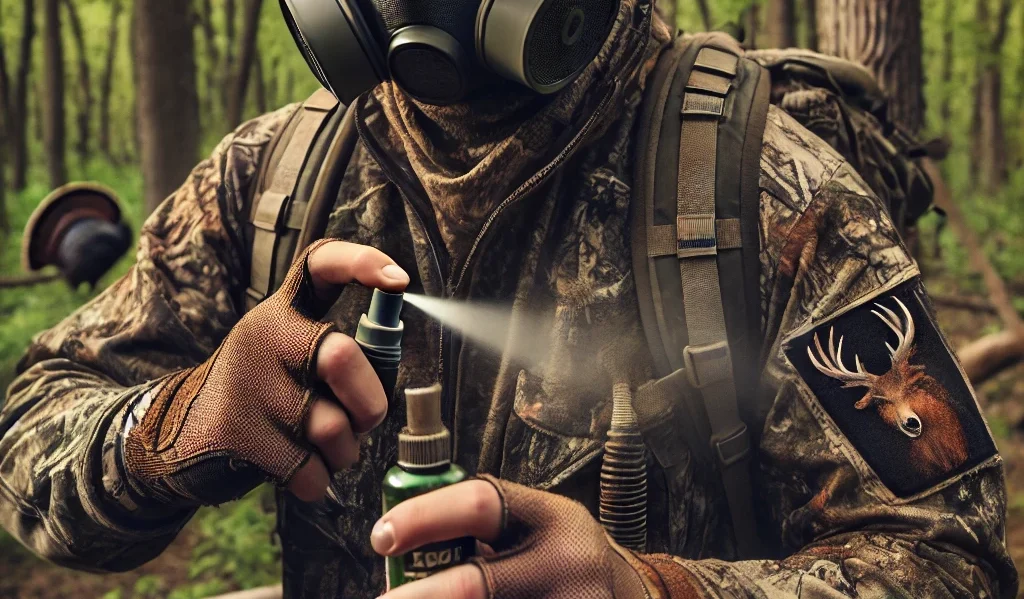
Now, I know what you’re thinking. “Scent control? For turkey hunting? Come on!” But hear me out. While it’s true that turkeys don’t have a great sense of smell, scent control can still play a crucial role in your hunting success. Let’s break down why it matters and how to do it right.
Why Bother with Scent Control?
- Other Wildlife: Deer, coyotes, and other animals with keen noses can alert turkeys to your presence. If a deer snorts or a coyote starts howling near your setup, you can bet that nearby turkeys will get nervous.
- Hunting Multiple Species: If you’re out for turkeys in the morning and deer in the evening, scent control becomes even more important.
- Close Encounters: In blind setups or when birds get very close, even a turkey might pick up on strong odors.
- Overall Woodsmanship: Good scent control is part of being a complete, conscientious hunter.
The Scent Control Process:
- Start Clean:
- Wash all your hunting clothes in scent-free detergent.
- Store them in a sealed container or bag with leaves or pine needles from your hunting area.
- Shower with scent-free soap before your hunt.
- Dress Smart:
- Dress in your hunting clothes outside or in a scent-free area.
- Use scent-free deodorant and avoid cologne or scented hygiene products.
- In the Field:
- Use a scent-eliminating spray on your outer layers and boots.
- Be mindful of where you walk – avoid stepping in strong-smelling substances.
- Post-Hunt Care:
- Air out your clothes after each hunt.
- Store them properly to prevent mildew or household odors from setting in.
Pro Tip: Keep a set of scent-free clothes just for hunting. Please don’t wear them for other activities.
Dealing with Human Odor
- Watch What You Eat: Strong-smelling foods like garlic or onions can seep through your pores. Stick to milder foods before and during your hunt.
- Stay Hydrated: Drinking plenty of water can help dilute and reduce body odors.
- Control Sweat: Use scent-free antiperspirant and consider scent-blocking base layers.
- Mind Your Breath: Use a natural breath freshener like mint leaves. Avoid gum or mints with strong artificial scents.
Scent Control for Your Gear
- Weapons: Wipe down your gun or bow with scent-eliminating wipes.
- Calls: Clean your calls regularly and store them in scent-free containers.
- Blinds and Seats: Air these before use and spray with a scent eliminator.
- Boots: Pay special attention to your boots. Use scent-eliminating spray and consider rubber boots, which hold less odor than leather.
Natural Scent Camouflage
- Local Vegetation: Crush some local leaves or pine needles and rub them on your clothes and gear.
- Dirt: Lightly dusting local dirt can help mask your scent and reduce the shine of your gear.
- Smoke: Some traditionalists swear by the smoke from a campfire to cover human scent. Just be careful not to overdo it!
Remember, scent control isn’t just about eliminating odors – it’s about blending in completely with your environment. Every little bit helps when you’re trying to outsmart a wary old tom.
Conclusion
And there you have it, folks – the complete guide to becoming invisible in the turkey woods. We’ve covered everything from understanding turkey vision to choosing the right camo, from breaking up your outline to controlling your scent.
Successful turkey hunting is about more than just looking like a shrub. It’s about becoming part of the environment, patience, stillness, and respect for these incredible birds and their keen senses.
So next time you’re out there, sitting against a tree in the predawn light, decked out in your carefully chosen camo, consider all the elements we’ve discussed. With practice and attention to detail, you’ll be well on your way to fooling even the wariest of gobblers.
